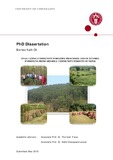Please use this identifier to cite or link to this item:
http://archive.nnl.gov.np:8080/handle/123456789/58| Title: | Evaluating community forestry processes and outcomes: evidences from mid-hill community forests of Nepal |
| Authors: | Oli, Bishwa Nath |
| Keywords: | Forest -- Nepal |
| Issue Date: | 3-Jan-2018 |
| Abstract: | With the overall objective to evaluate outcomes of decentralized forest governance in Nepal, particularly focussing on assessing forest conditions as well as the role of community forestry in household economies, this research was carried out in 10 community forests of Tanahun district of western Nepal. The fieldwork consisted of five components: forest measurement including boundary survey, household survey of 304 households, key informant interviews, counting and identification of farm trees, and focus group discussions. Different types of airborne analogue aerial photographs, satellite imageries (high resolution), digital topographic data (spatial data) and GPS data were also used for the study. Data were analyzed using ArcGIS 9.2, SPSS 16 and STATA 11 software. It was observed that, after decentralization, all forests were actively as well as sustainably harvested by local communities, supporting the general ‘conservation through economically rational utilization’ predictions of common pool resource management theory. Assisted by a general positive economic development, indefinite, exclusive and enforceable proprietor rights to valuable forests seemed to be the explanatory factors. The study further revealed that total forest income contributed about 5.8% to total household income, ranging from 3.8 to 17.4% for the richest and poorest, respectively. Community forestry income constituted about 49.7% of the total forest income, followed by 27.5% from government-managed forests, and 22.8% from private forests/trees. Analyses on poverty indices and decomposed Gini coefficients showed that incorporating forest incomes in total household income reduced measured rural poverty substantially, and income inequality to some extent. Out of 10 explanatory variables used in an OLS regression model, four in community forest regimes were significant; (i) low caste households generated higher forest incomes than higher caste households, (ii) households with the lowest land holdings generated more forest incomes than other households, (iii) households with high livestock holdings generated higher forest incomes than other households, and (iv) households that received higher remittances generated less forest incomes than other households. For private forest/tree regimes three variables turned out to be significant; (i) households with high land holdings generated higher incomes from private forests/trees than others, (ii) those with high livestock holdings derived higher incomes from private forests/trees than other households, and (iii) those who were close to markets generated higher incomes from private forests/trees than others. In government-managed forest only two variables were significant (i) those receiving high remittances also generated higher forest incomes and (ii) households who were far from markets generated less forest income than the other households. On-farm trees were found to be very important in terms of supplying firewood and especially fodder for the rural households. Land holdings, livestock holdings, firewood consumption, and education level were positively related to the number of trees on a household’s farm land while distance to the forest and the use of alternative energy sources were negatively related. One conclusion drawn is that tree products are vital to the most prevalent rural livelihood strategies and it is reasonable to believe that rural differentiation does not show itself in this aspect, but rather in assets that require more capital. Furthermore the results suggest that, overall moderate participation in community forestry activities is by far most common for rural households in the Nepalese mid-hills. Yet, there are several determinant factors which influence the level of participation. Of the 12 variables included in an analytical model, the following associations stood out as significant; male-headed households participated more than female-headed households, higher caste households participated more than lower caste households, households with high livestock holdings participated more than other households, households involved in many networks participate more than other households, and households that consume high amounts of firewood participated more than other households. Wealth class did, however, not seem related to the level of households’ participation. Nor did the amount of produce extracted from the community forests. Using the example of one community forest, the study showed that community defined and enforced access rules do not necessarily maintain forest species diversity or regulate the forest stand structure, because species with high economic potential tended to be over-harvested. A multitude of anthropogenic, socio-economic, and environmental factors, either alone or jointly, affected the forest structural, functional, and compositional aspects at varying scales and intensities, which play crucial roles in conservation, maintenance, and degradation of forest biodiversity in Sal (Shorea robusta) forests of Nepal. |
| Description: | University of Copenhagen, 2015. |
| URI: | http://103.69.125.248:8080/xmlui/handle/123456789/58 |
| Appears in Collections: | 300 Social sciences |
Files in This Item:
| File | Description | Size | Format | |
|---|---|---|---|---|
| Dissertation_Bishwa_Nath_Oli_Final_12_May_2015_FINAL.pdf | 3.2 MB | Adobe PDF |  View/Open |
Items in DSpace are protected by copyright, with all rights reserved, unless otherwise indicated.